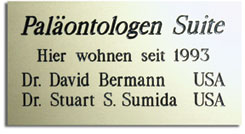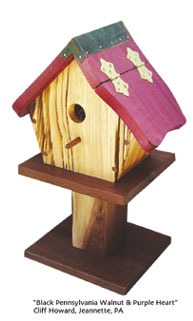Adventures in Germany
 R.J. Gangewere R.J. Gangewere
Dave
Berman finds celebrity—and some 290-million
-year-old fossils—during his 11 years at
work in the Thuringian Forest of central Germany.!
Since 1993, paleontologist David S. Berman has been
digging for fossils of primitive amphibians and reptiles
at the Bromacker Quarry in the Thuringian Forest, which
is near Gotha in central Germany. Until the re-union
of East and West Germany in 1989, this area in East
Germany was off limits to scientists from the West.
But now, after 11 years of work at the site, Berman
and his colleagues have achieved local celebrity status
with the townspeople in the neighboring villages of
Tambach-Dietharz and Georgenthal.
The paleontological team laboring in the quarry with
Berman includes three others: his German host, Thomas
Martens of the Museum der Natur, Gotha; Amy Henrici,
preparator, from Carnegie Museum of Natural History;
and Stuart S. Sumida, from California State University,
San Bernardino. This team has been digging up primitive
amphibians and reptiles from approximately 290 million
years ago, long before the Age of Dinosaurs.
 In the Hotel Comtel in Wandersleben (“Wanderer’s
life”), where the American crew stays, their
rooms have been dedicated with plaques: the “Paleontologist’s
Suite” for Berman and Sumida, and the “Preparator’s
Suite” for Henrici. Berman even sleeps in a bed
decorated by the appreciative hotel manager with an
American flag . Downstairs on the hotel restaurant
wall is a cast of two fossils found at the quarry,
and although their scientific name is Seymouria, they
have been given the colloquial name Liebespaar (“loving
couple”) by the German hosts because the specimens
were discovered cheek-to-cheek in the quarry. Also
on the wall is a display of pictures and news clippings
describing the local paleontology, as well as fleshed-out
models of the “loving couple.” In the Hotel Comtel in Wandersleben (“Wanderer’s
life”), where the American crew stays, their
rooms have been dedicated with plaques: the “Paleontologist’s
Suite” for Berman and Sumida, and the “Preparator’s
Suite” for Henrici. Berman even sleeps in a bed
decorated by the appreciative hotel manager with an
American flag . Downstairs on the hotel restaurant
wall is a cast of two fossils found at the quarry,
and although their scientific name is Seymouria, they
have been given the colloquial name Liebespaar (“loving
couple”) by the German hosts because the specimens
were discovered cheek-to-cheek in the quarry. Also
on the wall is a display of pictures and news clippings
describing the local paleontology, as well as fleshed-out
models of the “loving couple.”
Fossils and Bratwurst
The village of Wandersleben has made the scientists
Honorary Citizens, and on a recent fourth of July,
Berman and Sumida received a supply of gifts from the
village, including a box of cigars with their names
on the tubes. Local TV crews have descended yearly
on the site to make 8-10 minute programs about the
fossil dig. Berman recalls that when he first started
work at the quarry, he lived in unbearably cramped
quarters at a youth hostel, and became such an “unhappy
wanderer” that he had to move to the Hotel Comtel.
Now everyone knows when the paleontologists are in
town.
The Burgermeisters of the two nearby villages of Tambach-Dietharz
and Georgenthal each love the idea of having a new
species of fossil named after their towns. This cause
was advanced by the paleontologists when they named
a new species Tambachia trogallas. The name is from
the Greek trogo for “munch” or “nibble,” and
allas, for “sausage,” a reference to the
Thuringian bratwurst that the fossil hunters eat regularly
at the Bromacker Quarry.
Berman is not immune to this distant fame. Back in
his Pittsburgh office, he drinks from a coffee cup
imprinted with a picture of the “loving couple” of
Seymouria. The original fossils are now back in Germany,
after preparation by Amy Henrici, but Carnegie Museum
of Natural History has its own casts of the specimens
in the Vertebrate Paleontology collection.
A Productive Quarry
For more than a decade, Carnegie paleontologists Berman
and Henrici, together with their colleagues, have
been working the highly productive German quarry,
known since the mid-1800s for its “fossil footprints.” The
excavations since 1994 have been funded annually
by the National Geographic Society, with other support
from Carnegie Museum of Natural History.

Eudibamous
cursoris
— a running reptile known only from
this site.
To date the site has yielded many superbly preserved
fossils, unique to Europe but also sharing close relationships
to life forms found in the United States. This has
provided the first irrefutable biological evidence
of a pre-continental drift, and a continuous landmass
formed by North America and Europe. Prominent examples
of this commonality are the Seymouria specimens, a
grotesque-looking herbivore (vegetarian) called Diadectes,
and the sail-back reptile Dimetredon. Another example
is the first animal to run on two legs, Eudibamus
cursorius.
The new species underscore the way that scientists
often name new discoveries: after geographic or geologic
features, a unique feature of the anatomy, or sometimes
a unique circumstance, like good local bratwurst.
Finally, as an example of the impulse to “brand” a
community with unique symbolism—such as dinosaurs
in Pittsburgh, or cows in Chicago and codfish in Boston—the
Tambochia trogallas makes a point about the internationalism
of that impulse. While the Burgermeister of Tamboch-Dietharz
enjoys a kind of paleontological status for his town,
his neighbor, the Burgermeister of Georgenthal (who
points out that the Bromacker Quarry is technically
in his district), is still waiting. Georgenthal patiently
hopes for a new species to be discovered —hopefully
a Georgenthal something, in honor of German hospitality.
Corps of Discovery: The Natural History
of the Lewis and Clark Expedition
Through June 10, 2004
 The
species that were first recorded for science
by the Lewis and Clark expedition are displayed
at Carnegie Museum of Natural History. The
species that were first recorded for science
by the Lewis and Clark expedition are displayed
at Carnegie Museum of Natural History.
In 2003, Pittsburgh celebrated the bicentennial
of the Lewis & Clark expedition’s departure
from the city, and the celebration of that historic
voyage continues in cities across the country until
2006.
The journey
of Lewis and Clark lasted two and a half years—from Meriwether Lewis’s
departure from Pittsburgh in August 1803 to the
final return of the Corps to St. Louis in 1806.
To celebrate that great adventure, Carnegie
Museum of Natural History’s original exhibition,
Corps of Discovery: The Natural History of the
Lewis and Clark Expedition can be seen until June
10, 2004. No other exhibition in the country uses
actual specimens from scientific collections to
give such a unique look at the flora and fauna
that Lewis and Clark encountered.
 Garden Themes & Birdhouse Dreams VII Garden Themes & Birdhouse Dreams VII
Powdermill Nature Reserve is already preparing
for a spring 2004 event: the Garden Themes & Birdhouse
Dreams Annual Benefit on May 28, 2004.
Artistic people begin working now on the wonderful
array of one-of-a-kind fanciful birdhouses and
garden–related items that are auctioned off
to benefit the biological field station of Carnegie
Museum of Natural History. The popular event sold
out last year with 300 attendees. Advance reservations
are required, and there are awards and prizes for
the best artistry. The tradition was begun by Patricia
and Harvey Childs, owners of G-Squared Gallery
in Ligonier, and now includes a display of works
(May 19-27) at the Ligonier Library to be auctioned
off.
In 2004, the funds raised will help restore the
five major ponds in the bird banding area at
Powdermill, as well as the “hide” used to view
birds. For more information call 724.593.6105,
email info@birdhousedreams.com,
or visit the website: www.birdhousedreams.com.
Back to Contents |